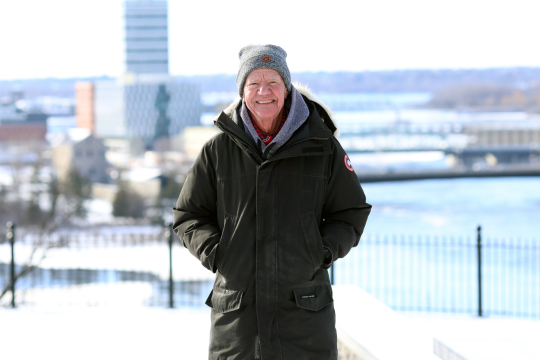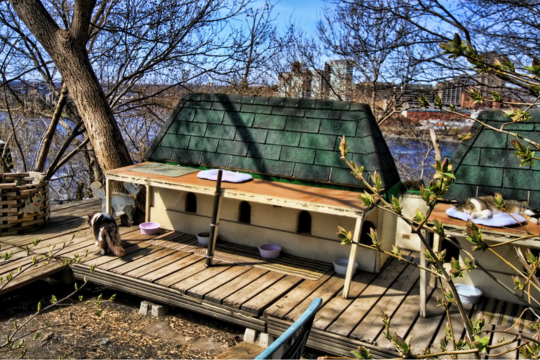
Brian Caines helped maintain the cat sanctuary on Parliament Hill and even adopted the last four cats. Photo: Dave Chan
The unofficial part of Brian Caines’ public-service career involved caring for some of Parliament Hill’s most famous residents, and certainly its most furry.
Caines’ near-35-year federal career in human resources and labour relations ended near Parliament Hill. It was there that he, like many tourists and other visitors, encountered the “Cats of Parliament Hill.“
For those who never had the experience, some background: The Cats of Parliament Hill were not hipster jazz musicians, but a ragtag group of feral/ abandoned domestic cats that became one of the most charming chapters in the history of Canada’s capital quarter.
The general recollection is that the cats arrived in the 1950s. “There were people who volunteered to take care of them in the 1950s,“ Caines says in an interview. “There was a story that they were mousers that lived in Parliament that were expelled in the ’50s and were left on the Hill. I don’t believe that story. I would think that if there were mousers in the Parliament buildings — and there undoubtedly were — if they got rid of them, someone would have taken them in.“
Whatever the murky origins, there were numerous cats living behind the West Block, among the bramble atop the steep slope down to the river. In clement weather, they were typically seen lounging about, singly or in groups, like drawings from a T.S. Eliot book. Many people helped to care for the cats over the years, most notably René Chartrand.
“When Parliament Hill was locked down after the 9/11 terror attacks,“ reported the Ottawa Citizen’s obituary when Chartrand, 92, died in 2014, “one of the few civilians allowed through the security cordon was René Chartrand. Canada might have been under threat of attack, but Parliament Hill’s cats still needed to be fed.“
Caines was quoted in the obituary: “He was a one of a kind. He was a unique individual. God bless him, because he’s an example to anyone for kindness.“
People who had met Chartrand left kind memories on the Cats of Parliament Hill Facebook page. (Yes, the cats have their own Facebook page. Clips abound on YouTube, including one visit from a Japanese TV crew.)

The makeshift shelters volunteers built over the years for the cats, who had one of the best views in the city of Ottawa. Photo: Wendy Hollands
The cats’ final days on the Hill were in 2013, when only a few were still in residence. The motley mix of wooden shacks Chartrand and others had erected for them over the years were dismantled. Today, only memories remain.
That’s the story of the cats, so how did Caines get there?
Caines is from Cornerbrook, N.L., and studied at Memorial University. In 1974, post-MUN, he moved to Vancouver. Soon, through mutual friends, he met Lammert Prinsen. It was a fateful moment. “We have been together 50 years in May 2025,“ Caines quips, “but who’s counting?“ (Prinsen retired from Statistics Canada in 2008.)
He gained a life partner and, over the years, lost his Newfoundland accent and expressions — mostly.
“Like, I’ll say ‘I find my arm,’ which means I have a pain in my arm. In Newfoundland, when you have a muscle cramp or anything you’ll often say ‘I find my arm’ or ‘I find my leg’, ‘I find my knee.’ And people will say, ‘I didn’t know you lost it.’“
Caines’ federal career began at the Post Office in Vancouver, and eventually included positions in Agriculture and Agri-Food Canada, the National Parole Board, the Privy Council Office and finally, the Courts Administration Service, “which is a combination of all the lower courts, other than the Federal Court.“ He retired in 2007.
His final workplace was steps from Parliament Hill, which is why he was strolling during a lunch break in the early 1990s and met the cats. Chartrand, the “Catman of Parliament Hill“ was elderly, and needed help caring for the colony.
“There were a number of volunteers who kind of helped,“ Caines recalls. “I co-ordinated. I had to work with Public Works and the RCMP, so if there was anything going on for security, if we were taking stuff up on the Hill, we had to let them know beforehand.“
The cats required constant care, their feral natures notwithstanding. If new cats showed up, Caines and other volunteers would round them up, have them treated and sterilized (Alta Vista Animal Hospital looked after them) and adopted through the Ottawa Humane Society “before they got too integrated into the sanctuary. Because, although I really liked the sanctuary, cats living outdoors is not ideal.“
He vividly remembers particular challenges, such as capturing mother cats with new kittens. “I was there through the bramble looking for them, in my shirt and tie sometimes.“
The colony had survived many challenges over the years, but by 2010 there “were only five or six [cats] living there,“ and they faced an intractable obstacle: the coming, multi-year renovation to all the nearby Parliamentary buildings. “It was the best time to end it,“ Caines says. “They were all getting older; they had to have medical care.“
The end of the cat colony was international news, with articles published in Germany, Denmark, Japan and the U.K., he says. “The Daily Telegraph did a huge, really good piece on the cats.“
The last few cats were adopted out. At one point, Caines and Prinsen had adopted four that had been cats of Parliament Hill, all with special medical needs. The last cat captured on the Hill was Bugsy. “He was a very wily, and we took him.“
The last surviving cat is Coal, and his owner, Danny Taurozzi, has an ongoing GoFundMe campaign for Coal’s medical care. As of Feb. 3, it had raised almost $14,000.
Caines’ life post-retirement includes a lot of volunteering and he seems fit and affable. He and Prinsen live in Ottawa’s Little Italy neighbourhood and Caines volunteers almost every day. Some volunteering is formal, such as offering himself as a guinea pig for University of Ottawa studies on how heat and sleep affect the human body.
“If they need someone to poke and prod and stick electrodes on, I’m their man.“ Such volunteers are paid, but Caines declines the money. “If I were a student, I’d be taking it, and I certainly don’t criticize anyone who does take it, but I’ve never had to and that gives me a lot of satisfaction.“
Other volunteering is informal, such as walking neighbours’ dogs, and walking neighbourhood kids to a nearby school every day. It began when one neighbour child, Stella, started kindergarten. Stella is now in university.
“I would walk her to school, and I noticed neighbours were also walking their kids to school,“ he says. “They all work, and I didn’t, so I said if you want me to walk your kids to school, it’s no problem. I think I got up to seven at one point, but now I’m down to three. I’m a morning person, so getting out with the kids is just a good way to start the day and it helps parents. That’s one less thing they have to worry about.“
He also helps a teacher friend who takes groups of pupils to Ottawa’s museums. “I’ve got the time, I like kids. And I get into the museum for nothing.“
He’s also a frequent writer of letters to the editor, and has had many published over the years. “I try to keep it short [and] be a bit pithy.“ He is, in short, the model of what every newspaper editor wants a letter writer to be.
The years have brought Caines and Prinsen, who both joined the association in 2010, a cosy life in central Ottawa. There is, of course, a cat, Sally, who came with that name when adopted from a shelter.
“She was a special-needs cat and was 10 years old. It’s harder to adopt older animals, especially when they require special care, so we took her in, and Bob’s your uncle.“

